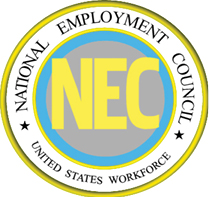
Questions and Answers
What is the NEC Goal?
Our goal is to find employment for 5000 annually. We also strive to service 500 new employers per year.
How Does the NEC Program Get Me Back To Work?
Our Career Coaches are experts at creating employment opportunities for candidates. We work with employers in each area to train and match candidates with jobs. By completing the Get Back to Work Now program, graduates are assigned to a job search assistant and are matched with jobs within 16 weeks.
Is there a cost?
No, NEC programs are free and open to the public.
How does NEC get its funding?
What is Project Get Back to Work Now?
This is a structured educational program with that provides our workforce with job finding strategies. Through a structured process using skills training, career coaching, and job matching, the program helps unemployed members of each community to secure employment. The program is open to the public with a special focus on Veterans, families experiencing homelessness stemming from unemployment and the long-term unemployed (those unemployed for longer than six months). View program details
How is Project Get Back To Work Now different?
There are many plausible employment finding services within every community, some private and some government sponsored. Yet, the National Employment Council program is uniquely structured in several ways:
- This program is unique as it accompanies Job Matching. The National Employment Council has established relationships with employers in territories it services. Employers have agreed to interview graduates of project Get Back to Work Now after candidates have completed the six week Get Back to Work Now program. Job matching is an important distinguishing factor, offering graduates of this program a direct advantage.
-
This program is unique as it builds personal morale prior to applying for a job:
Job seekers with the desire to organize, execute and mange a successful employment campaign share three qualities: vision, hope and motivation. Although most join the unemployed community possessing all three qualities, extended unemployment gradually diminishes these traits and replaces them with doubt and lowered self esteem. The excitement to secure employment is eventually replaced with skepticism, loss of interest, and even for some, depression. Continuous rejection and lack of forward momentum can impact individuals with the potential to become viable members of the workforce. Project Get Back to Work Now is distinguished by focusing on revitalizing the belief and motivation for each candidate giving them the foundation and the forward momentum they need to succeed. More emphasize is placed on this step prior to applying for a job, than it is on building a resume or preparing for an interview. -
This program is unique at it builds communication skills before applying for a job:
With more than three millions open positions nationally, unemployment exists for many, not due to lack of jobs, but lack of communication. Perfectly qualified candidates overstate or under describe their abilities and are eliminated from the process when talent management software are unable to accurately match their skills to open positions. Furthermore, lacking the knowledge to convey their transferrable skills, some limit themselves when narrowing their options. An IT project manager may possess transferrable skills that may benefit a wide variety of organizations looking for project managers, but this candidate may not know how to communicate those skills to a new employer. The ability to communicate across various platforms increases the marketability of each candidate in an employment market where employers are having difficulty filling their open positions. Communicating one's skills correctly is important as it prevents the wrong perception from forming by employers who may regard a perfectly qualified candidate as not compatible. Being considered as overqualified, under-qualified, or not qualified, all result from a resume containing too much, not enough, or the wrong information. To be regarded as perfectly qualified, one must communicate their skills clearly. The NEC program prepares applicants to communicate their skills so clearly, employers looking for those skills can quickly find them. This makes the NEC program unique.
-
This program is unique as it accompanies career coach support:
Factors such as a skills gap, globalization and advancements in technology have created a volatile employment landscape that is constantly changing. Job seekers entering the job market for the first time find this new job market shockingly different than the one they were accustomed to in the 80's and 90's. Consequently, using outdated strategies; hundreds of unproductive hours are spent applying to online postings to which little responses are received. As a result, an otherwise productive workforce is preoccupied with activities seemingly relevant, yet fruitless in nature. When candidates spend hours online, completing profiles, taking application tests and assessments, for jobs that are seemingly legitimate, yet their existence suspect, a new generation of unemployed is created who are squandering time with activities that yield little or no plausible results; time they could otherwise use to advance their careers. Unproductive weeks turn into months, eventually perfectly qualified candidates lose the ambition to keep moving forward. This program affords each Get Back to Work Now graduate with a career coach, until employment is realized. This access ensures that participants have the guidance needed to remain productive and generate momentum while searching for employment. Momentum creates hope, hope reignites motivation, and motivation generates the ambition needed to continue moving forward until employment is realized.
-
This program is unique as it focuses on what works, not what is popular:
Unaware that finding employment today is no longer a two-step process, candidates continue submitting resumes to which they receive no responses to. Today creating a resume (step one), and applying online for jobs using that resume (step two) is most commonly used, yet no longer lead to employment. These steps are outdated and only blend the average applicant with thousands of others following the same two steps. For most, losing a job occurs so unexpectedly, new to the employment market, these steps are the only ones they know. An accountant knows accounting as a salesperson knows how to sell. Yet, the average job seeker is not an expert when it comes to looking for employment. Consequently, steps are taken not because they work, but because they are popular. Here are some examples of outdated steps that are popularly used: - Submitting a resume prior to establishing a definite career path
- Applying for jobs online
- Applying for jobs using a functional resume
- Pursuing a career before finding a job
- Squandering time searching for employers in the wrong places
- Including too much or the wrong information on a social media profile
- Sharing outdated information during an interview and consequently being eliminated from the process
- Wasting time on networking that generates leads VS networking to gain referrals
Accepted strategies, no longer relevant used by a generation more than 35 years ago, only prolong unemployment today. Just as the automobile replacing the horse carriage transformed the transportation industry, the internet replacing the classified ads transformed the employment industry as well. Small adjustments in how employers are pursued today, makes a significant difference in connecting with those employers. This program helps candidates remain focused by doing what works as opposed to what is popular.
What are the details of the Project Get Back to Work Now workshops?
For six weeks (one day per week from 8:30 to 1:00 p.m.), participants prepare to meet with employers. Following each session, participants practice the theme of each class for one week using the accompanying training guides (See below) as reference. The one week gap in-between each class allows participants to exercise learned concepts (Exercises are important as more than 90% of information taught in any workshop is typically forgotten within 72 hours) with the aim of internalizing the information. Upon completion, graduates are shown how to apply for jobs that would make them compatiple to open positions in their area.
For 30 days following graduation, graduates of this program can meet with a career coach on location at anytime to get help on their search. Assistance by a career coach is offered only in-person and on-location. Job matching is offered through online aggregators and employer relationships. Every graduate’s marketable skills are identified and paired with a position offered by employers registered in this program. NEC does not guarantee jobs for graduates of this program . Yet, our coaches will do whatever they can to help graduates secure employment.
Event is open to the public and free to all job seekers.
For 30 days following graduation, graduates of this program can meet with a career coach on location at anytime to get help on their search. Assistance by a career coach is offered only in-person and on-location. Job matching is offered through online aggregators and employer relationships. Every graduate’s marketable skills are identified and paired with a position offered by employers registered in this program. NEC does not guarantee jobs for graduates of this program . Yet, our coaches will do whatever they can to help graduates secure employment.
Event is open to the public and free to all job seekers.
What are the Hidden Step® Guides?
The Hidden Step® series are five guides distributed complimentary at the Get Back to Work Now workshops. Each guide focuses on a specific theme used to compliment each session. Participants use the guides as review following each session. See below for description of each book.
-
GUIDE ONE: Ignite Your Inner Fire
This guide is offered on the first day of class. Taking action, moving forward and generating momentum is necessary when searching for a career. The ambitions to organize, execute and follow up are important values to possess when looking for a new career. Yet, extended unemployment can lower the presence for these values. To heighten one's morale and restore the motivation every person needs to be successful when searching for employment, the first day of the Get Back to Work Now training accompanies Guide one, Ignite Your Inner Fire. This guide allows each participant to recognize inner potential they possess, and introduce ways they can utilize this potential to achieve the career they aspire to have. View Guide One -
GUIDE TWO: Identify Your Career Path
This guide is offered on the second day of class. Being eager to get back to work, the average candidate rushes to create a resume, submitting it as quickly as possible. Yet, when candidates merely verbalize their past by describing a series of work experiences on a resume, they risk conveying an otherwise perfectly matching qualification as contradictory to the position's requirements. Globalization today offers employers access to a broader pool of candidates allowing them to be more selective. To remain competitive, successful candidates construct the content of their resume by considering several important factors, (similar to factors considered by an advertising agency prior to launching a marketing campaign); factors such as demographics, a target market, trends and a budget. In addition, prior to creating a resume, job quantity, competition, and the "career opportunity scope" should also be carefully considered. Creating a resume without these considerations can result in a resume constructed purely by chance and content that may convey an otherwise matching qualification as not matching. Guide two helps each participant distinguish themselves by becoming clear and concise on how to communicate to an employer. Identifying the career path helps each person achieve clarity, a sense of direction and the knowledge to organize and place their personal qualifications in a manner that resonates with employers. View Guide Two -
GUIDE THREE: Prepare for the Phone Interview
This guide is offered on the third day of class. Just 10 years ago, the phone interview did not exist. Today it is used as a fast and inexpensive tool to screen out candidates. An unprepared candidate can be eliminated from the process, even if he or she has a stellar resume. Many well qualified candidates are eliminated at this step when they find themselves ill prepared to handle the call. Guide three prepares the candidate with the knowledge to be concise, relevant and deemed compatible during the phone interview, turning every phone interview into a face-to-face meeting. View Guide Three -
GUIDE FOUR: Construct A Resume That Works
This guide is offered on the fourth day of class. The resume has a job to do for every applicant. Today, the goal from creating a resume is NOT to obtain employment, but to generate a phone call. Being unaware of how to construct a resume that achieves this goal, candidates submit resumes to which they receive little or no responses to. Additionally, reacting to changes in the new job market, the average candidate possesses limited knowledge on where and how to apply for jobs. Consequently, some find themselves as being considered as overqualified, under-qualified, or not qualified, resulting from a resume containing too much, not enough, or the wrong information. Guide four helps participants of this program to package their skills according to their strengths, and become compatible by focusing on areas employers value. View Guide Four -
GUIDE FIVE: Managing the Apply and Interview
This guide is offered the fifth day of class. Today, most employers use talent management software to manage applicant resume submissions. Employers are just as eager to fill their open positions, yet it is no longer a numbers game. If the first ten employers did not view a resume as a match, chances are other employers will not either. Therefore, it is important that we educate the unemployed members of our workforce with the correct strategies when applying for employment. Once the employer has responded, it is equally as important to prepare the applicant for the interview. Guide five is the final step and offered during day five and six of the Get Back to Work now workshops. After the applicant has learned the best strategies to apply and interview, the applicant is matched with employers looking for his or her skills. (Copy under revision) View Guide Five
What projects does NEC sponsor?
NEC Sponsors the following projects:
-
Project Hero to Hire
This project dedicates a team to facilitate Veterans through the Get Back to Work Now program. We plan to partner with Veterans service organizations to invite unemployed veterans to join the Get Back to Work Now workshops. Upon graduation, a career coach is assigned to each veteran for 12 months to act as a guide until employment is realized. Read More -
Project Hope
This project dedicates a team to facilitate Homeless families through the Get Back to Work Now program. We plan to contact homeless shelters to invite families experiencing homelessness stemming from unemployment to join the Get Back to Work Now workshops. Upon graduation, a career coach is assigned to each person for 12 months to act as a guide until employment is realized. Watch Video -
Project Imagination
This project focuses on the youth; helping our youth embrace a culture of innovation. The Genius Fun Fair and the Imagination Expos are both events our team is currently working on organizing. Read More -
Project Get Back to Work Now
We host employment workshops to prepare unemployed members of the workforce in each community prior to applying for employment, we then provide a career coach for each member following the workshop series and host career events to match each member with jobs in their area. The Workshops are conducted through a project called Get Back to Work Now and are hosted online as well as on-location at community locations such as Churches, libraries, colleges, Veterans Affairs offices, workforce centers and community centers. The hours of the workshops are from 8:30 a.m. to 1:00 p.m. Read More
What is the difference between a Career Coach and a Job Search Assistant?
A Job Search Assistant is a guide for Get Back to Work Now participants, answering basic questions and helping them graduate from the program. Some job search assistants are trained volunteers. A Career Coach is an employment expert with years of HR experience and uptodate knowledge of the employment market. A Career Coach is in charge of facilitating the Get Back to Work Now workshops and helping place graduates. Participants of the Get Back to Work Now workshops can call (888) 440-8808 to reach a job specialist or contact the Director at (949) 870-0201.
Why does NEC focus on our Veterans?
Our Veterans sacrificed their lives when serving and should not be asked to sacrifice their lives even further when looking for employment. Although our Veterans acquire important skills while in active duty, being in the Military for an extended period, some lose the edge to compete for civilians jobs. Reintegrating back into the civilian workforce for our veterans is more challenging and requires special assistance. It is our duty to ensure they find employment quickly. Watch Video
Why does NEC focus on homeless families?
For some families employment does not arrive on time. When families lose their homes, children lose their security. Life quickly takes on new meaning when children are forced to live at a shelter or even in their cars and hide this new lifestyle from their school friends. It is our responsibility to dedicate special attention to this group to ensure families can restore their lives and preserve for our children, our future, their dignity. Watch Video

Employer Impact
Learn about the NEC system that improves employer/employee relations for small to midsized companies
See more





